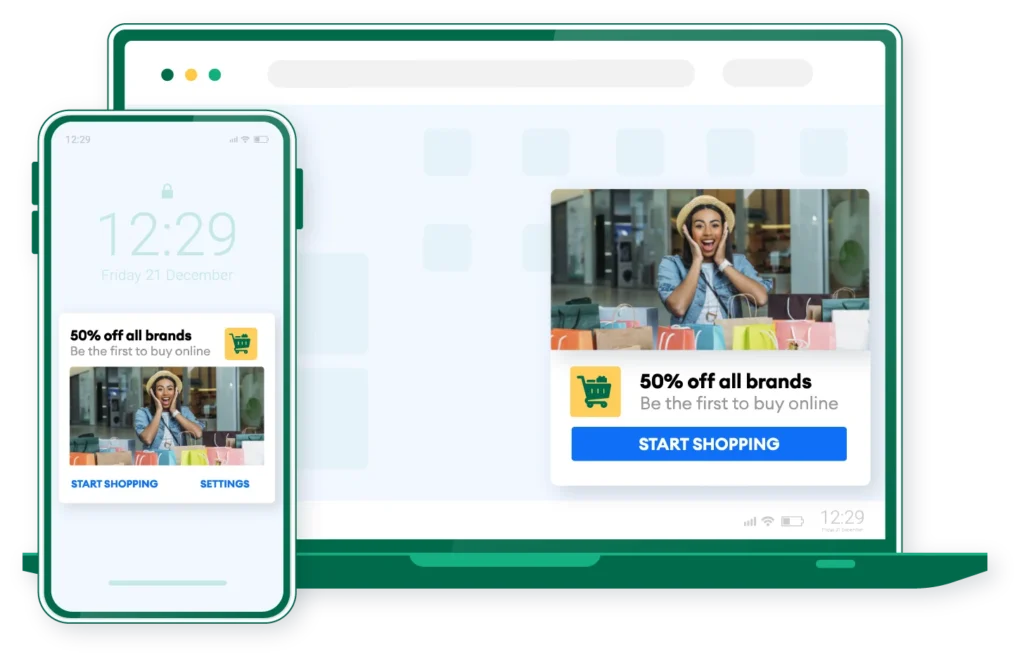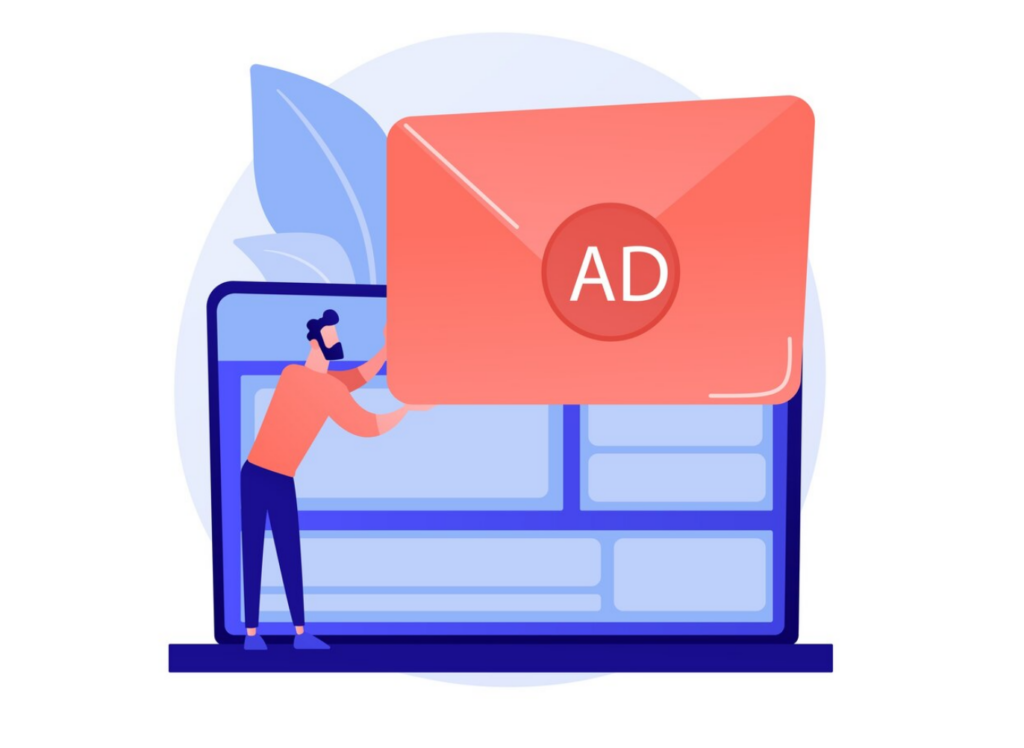In today’s digital advertising world, marketers are constantly looking for innovative ways to engage users. Among the many strategies that have surfaced, Push Ads have emerged as one of the most effective tools in digital marketing. Push advertising utilizes push notifications to send messages directly to a user’s device, providing a direct channel to engage with potential customers.
This guide will delve into everything you need to know about push ads, how they work, their benefits, challenges, and how businesses can use them for better marketing results.
What Are Push Ads?
Push ads are a form of online advertising delivered through push notifications. These notifications appear directly on users’ devices, such as desktops, smartphones, or tablets, even if they are not actively browsing a website or using an app.

When users opt-in to receive notifications from a particular site or app, push ads can be sent anytime, delivering content, promotional offers, or announcements.
Push ads come in various formats:
- Web push ads: Delivered through web browsers.
- Mobile push ads: Sent through mobile apps.
- In-app push ads: Delivered within apps, often as part of the app’s own messaging.
Unlike traditional ads like banners or pop-ups, push ads reach users who have expressed interest by opting in for notifications. This makes them highly targeted and potentially more effective.
How Do Push Ads Work?
The mechanics of push ads are fairly simple but highly efficient. Here’s a basic breakdown of how they work:
- User Opt-in: A user visits a website or uses an app that offers push notifications. They are prompted to allow notifications. If they opt-in, they become part of that website or app’s push notification subscriber list.
- Push Notification Service: Once a user opts in, their device is registered with a push notification service (like Google Firebase for Android or Apple Push Notification Service for iOS). This enables the site or app to send notifications directly to that user.
- Ad Delivery: Marketers or advertisers use a push ad network or platform to create and schedule push ads. These platforms manage the delivery of push ads based on user demographics, interests, or behavioral data.
- User Interaction: Once the push ad is sent, it appears on the user’s screen, prompting them to take action (click the ad, visit a site, download an app, etc.).
Types of Push Ads

There are various types of push ads, each serving different purposes based on the platform and goals. Here are the most common:
- Web Push Ads
- Delivered via web browsers (e.g., Chrome, Firefox, Safari).
- Users receive these notifications even if they are not on the website.
- Works well for driving website traffic, offering deals, or re-engaging users who haven’t visited recently.
2. Mobile Push Ads
- These are sent via mobile apps.
- Users must have the app installed and opted in to receive notifications.
- Great for engaging app users, reminding them of an unfinished purchase, or promoting new features or deals.
3. Rich Push Notifications
- Enhanced push notifications that include multimedia elements like images, videos, and GIFs.
- These are more visually appealing and drive higher engagement than standard text-only push notifications.
4. Transactional Push Ads
- Notifications triggered by specific user actions, such as confirming a purchase or reminding a user to complete a transaction.
- These are highly personalized and often directly linked to the user’s behavior on the site or app.
5. Triggered Push Notifications
- Sent based on predefined triggers, such as a user not logging into the app for a week, abandoning a shopping cart, or browsing a particular category.
- Designed to re-engage users or remind them of unfinished actions.
Benefits of Push Ads
Push ads offer numerous advantages that make them stand out in the world of digital advertising:

1. High Engagement Rates
Since push ads appear directly on a user’s device, they are hard to miss. When users opt-in, it indicates interest, making these notifications much more likely to be clicked than traditional ads. Engagement rates for push ads are typically higher than for other ad formats like email marketing or display ads.
2. Real-time Communication
Push notifications allow businesses to communicate with users in real-time. This is particularly beneficial for time-sensitive promotions, updates, or announcements. The immediacy of push ads makes them highly effective for flash sales, breaking news, or urgent updates.
3. Personalized Advertising
Push ad platforms allow advertisers to segment their audiences and target users based on demographics, interests, or behavior. This enables marketers to deliver personalized content that resonates with the user, which increases the likelihood of engagement.
4. Cost-effective
Compared to other forms of advertising, push ads can be more cost-effective, especially when you consider their high engagement rates. For small businesses or startups, push ads can be an affordable way to reach a large audience without breaking the bank.
5. Works Across Platforms
Push ads can be delivered across multiple devices—desktops, tablets, and mobile phones. This multi-platform capability ensures that users receive the message wherever they are, whether at their desks or on the go.
6. Increases Customer Retention
Push notifications are excellent for re-engaging users and increasing retention. Sending reminders, promotions, or useful information helps keep your brand top-of-mind and encourages users to return to your site or app.
Challenges of Push Ads
While push ads offer many benefits, they also come with certain challenges:
1. User Opt-in Requirement
One of the biggest hurdles with push ads is that users must opt-in to receive notifications. If a user declines to receive push notifications, you lose the ability to reach them through this channel.
2. Over-saturation
Push notifications can become overwhelming for users if overused. Sending too many push ads can lead to users opting out or, worse, uninstalling the app or blocking notifications entirely. Marketers need to strike a balance between engaging users and not bombarding them with too many messages.
3. Limited Content
Push notifications are generally short and concise, meaning there’s limited space for text. While this brevity can be an advantage for grabbing attention, it also limits the amount of information that can be conveyed in a single notification.
4. User Annoyance
If push ads are irrelevant or too frequent, they can annoy users. Advertisers need to carefully manage their campaigns to ensure that the notifications they send are valuable and well-targeted.
How to Create an Effective Push Ad Campaign?
Now that you understand the basics of push ads, let’s talk about how to create a push ad campaign that drives results.
1. Target Your Audience
The first step to a successful push ad campaign is understanding your audience. Use demographic data, behavioral data, and past engagement metrics to segment your audience and send highly targeted push ads. The more relevant the content, the better the results.
2. Craft a Compelling Message
Your push notification should be clear, concise, and compelling. Since users may only glance at the notification for a few seconds, it’s crucial to make your message short and to the point. A strong call-to-action (CTA) can drive clicks and encourage engagement.
3. Timing is Everything
The timing of your push ads can significantly impact their success. Sending push notifications at inconvenient times can lead to frustration. For instance, avoid sending ads early in the morning or late at night. Instead, send notifications when users are most likely to engage, such as during lunch breaks or evening hours.
4. Test and Optimize
Like any advertising campaign, it’s essential to test and optimize your push ad strategy. A/B testing different headlines, messages, and delivery times can help you identify what resonates most with your audience. Regularly analyze engagement metrics to fine-tune your approach.
5. Use Personalization
Personalized notifications perform better than generic ones. Use data like users’ past behavior, preferences, and demographic information to tailor your push ads to the individual. Adding the user’s name, mentioning a recent action they took, or recommending products based on their interests can increase engagement.
6. Offer Value
Push ads should always provide value to the user. Whether it’s a special offer, useful content, or an important update, the notification should be worth the user’s attention. Avoid sending push ads just for the sake of it. Instead, think about how each notification benefits the user.
7. Monitor Frequency
Be cautious about how often you send push ads. While it’s essential to stay top-of-mind, sending too many notifications can annoy users and lead to higher opt-out rates. Find a balance between staying relevant and not overwhelming your audience.
Push Ad Networks: Where to Run Your Campaigns
If you want to run a successful push ad campaign, choosing the right push ad network is key. Here are some of the top networks to consider:
1. PropellerAds
PropellerAds is one of the most popular push ad networks. They offer a self-serve platform with a wide range of targeting options, including user behavior, device type, and location. PropellerAds has a global reach, making it an excellent choice for advertisers looking to target audiences worldwide.
2. RichPush
RichPush is another leading push ad network, known for its advanced targeting features and high-quality traffic. With RichPush, you can create highly personalized campaigns and access detailed analytics to optimize performance.
3. AdMaven
AdMaven provides access to millions of push notification subscribers and offers a wide variety of targeting options. Their platform is user-friendly,
making it easy for beginners to create and launch push ad campaigns.
4. MegaPush
MegaPush was one of the first networks to offer push notification ads, and it remains a popular option for marketers. With a large audience base and competitive pricing, MegaPush is a great choice for advertisers on a budget.
5. PushGround
PushGround focuses on providing high-converting push ads for various industries. Their platform offers real-time analytics and allows advertisers to adjust their campaigns on the fly.
Case Studies: Success Stories with Push Ads
Case Study 1: E-commerce Brand
An e-commerce clothing retailer used web push ads to re-engage users who had abandoned their shopping carts. By sending a personalized push notification offering a 10% discount, the brand saw a 25% increase in conversions and a 12% reduction in cart abandonment rates.
Case Study 2: Mobile Gaming App
A mobile gaming app used push ads to notify users of new game updates and limited-time events. By leveraging triggered notifications, the app saw a 35% increase in daily active users and a 20% increase in in-app purchases.
Case Study 3: News Website
A news website used push ads to send breaking news alerts to its subscribers. The real-time nature of the notifications led to a 40% increase in page views and significantly boosted user engagement during peak news events.
Conclusion: Are Push Ads Right for Your Business?
Push ads offer a powerful way to engage with users, drive traffic, and boost conversions. They are cost-effective, highly targeted, and capable of delivering real-time messages directly to users. However, they must be used wisely. Over-saturation or poorly timed notifications can lead to user fatigue and opt-outs.
If you’re looking for a way to re-engage users, provide timely offers, or increase customer retention, push ads are worth considering. By understanding how they work, crafting a compelling strategy, and utilizing the right networks, your business can tap into the potential of push ads to drive meaningful results.
